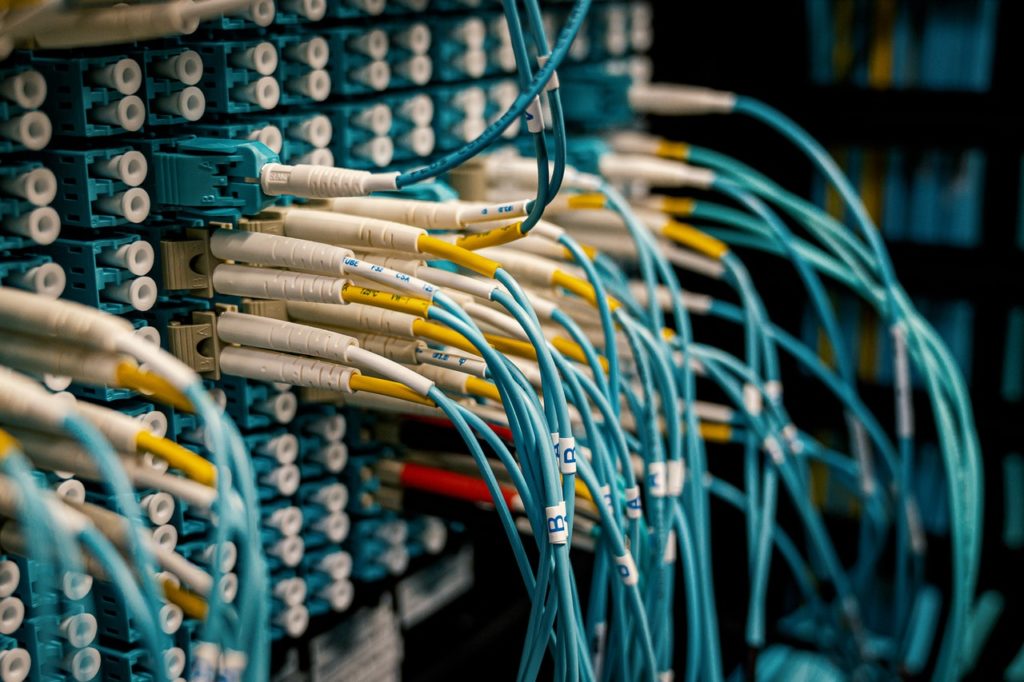
I learned this today. A fiber optic cable works by sending information encoded in a beam of light.
Different technologies send information in different ways. A telegraph and an old style telephone send signals with electric currents. A cell phone uses radio waves. A fiber optic cable sends signals using light.
Fiber optic cables were invented in 1952. In the 1840s, French inventors Dabiel Colladon and Jaques Babinet worked out that it was possible to guide light over a long distance using refraction. In 1850, an Irish inventor called John Tyndall, demonstrated that it was possible to bounce light along a stream of water. He called this a “light fountain”. This is basically the principle behind how a fiber optic cable works, except it is not water, of course.
The theory behind it is called total internal reflection. It happens when light is travelling along one medium and is reflected back into it by another medium surrounding the first medium. For example, light in a fish tank. The light heads towards the surface, but is reflected back by the air above the water, rather than simply just escaping into the air. This is because the air has a higher wave speed than the water. This is what makes the surface of a fish tank look like a mirror when viewed from below. The light from the bottom of the fish tank heads up to the surface. If the angle is just right, the light isn’t refracted out into the air, but is refracted back into the water. This gives the reflections.
In 1952, Narinder Singh Kapany invented the first fiber optic cable. He was an Indian-American physicist and he is known as the “father of fiber optics” by people who have heard of him. Unfortunately, as the inventor of something so world-changing, he is not as well known as he should be. Fortune magazine called him “One of the unsung heroes of the 20th century”. He should have won a Nobel Prize. He came up with the name fiber optics in 1960.
A fiber optic cable has two parts: the core and the cladding. They are both made of glass or plastic, but different types of glass or plastic. They are selected so that their wave speeds are different. The cores are about 1/10th as thick as a human hair. Many cores are bundled together in one cable.
When you use your computer at one end of the cable, your computer uses a laser to turn the signal into light pulses. These light pulses shoot along the cable at the speed of light. (OK, 70% of the speed of light. The speed of light is only 100% the speed of light in a vacuum. In the fiber optic cable it is slowed down.) Where the cable is curved, the light photons head towards the edge of the cable, but are refracted back into the cable because the wave speed of the cladding is much higher, in the same way as our fish tank example. This means the light signal never leaves the cable so long as the cable doesn’t bend by a great angle. When the signal reaches the other end, the connected device uses a photoelectric cell to convert the light pulses back into an electrical signal.
Modern fiber optic cables can carry over 1 petabyte of data a second. This is a huge amount and means 100,000s of phone calls at the same time.
Fiber optic cables have a lot of advantages over the copper cables that are used for phonelines, and over the radio waves that are used for cell phones. Light in a fiber optic cable suffers from far less signal loss over a long distance than electricity in a copper cable suffers from. This means that fiber optic cables can stretch much farther than a copper cable. The main Internet lines that run under the oceans are only possible because of fiber optic cables. A copper cable would have to be amplified every so often. Radio waves are even worse because there must be a line of sight between the device and the receiver. Your cell phone won’t work unless you are close to the tower.
Fiber optic cables are also more secure. It is possible to tap into a copper cable and read the information that is passing because it is a simply an electrical signal. It is impossible to do this with a fiber optics cable. Fiber optics are also more cost effective and can carry far more information.
So, the idea behind fiber optics was discovered in the 1840s but the cables were only invented in 1952. Since then, they have improved dramatically. They work by refracting a light signal along a glass or plastic tube. And this is what I learned today.
Sources:
https://electronics.howstuffworks.com/question402.htm
https://www.explainthatstuff.com/fiberoptics.html
https://en.wikipedia.org/wiki/Fiber-optic_cable
https://www.um.es/docencia/barzana/DIVULGACION/TELEFONIA/Funcionamiento_telefono.html
https://en.wikipedia.org/wiki/Narinder_Singh_Kapany
https://en.wikipedia.org/wiki/John_Tyndall
https://en.wikipedia.org/wiki/Total_internal_reflection

